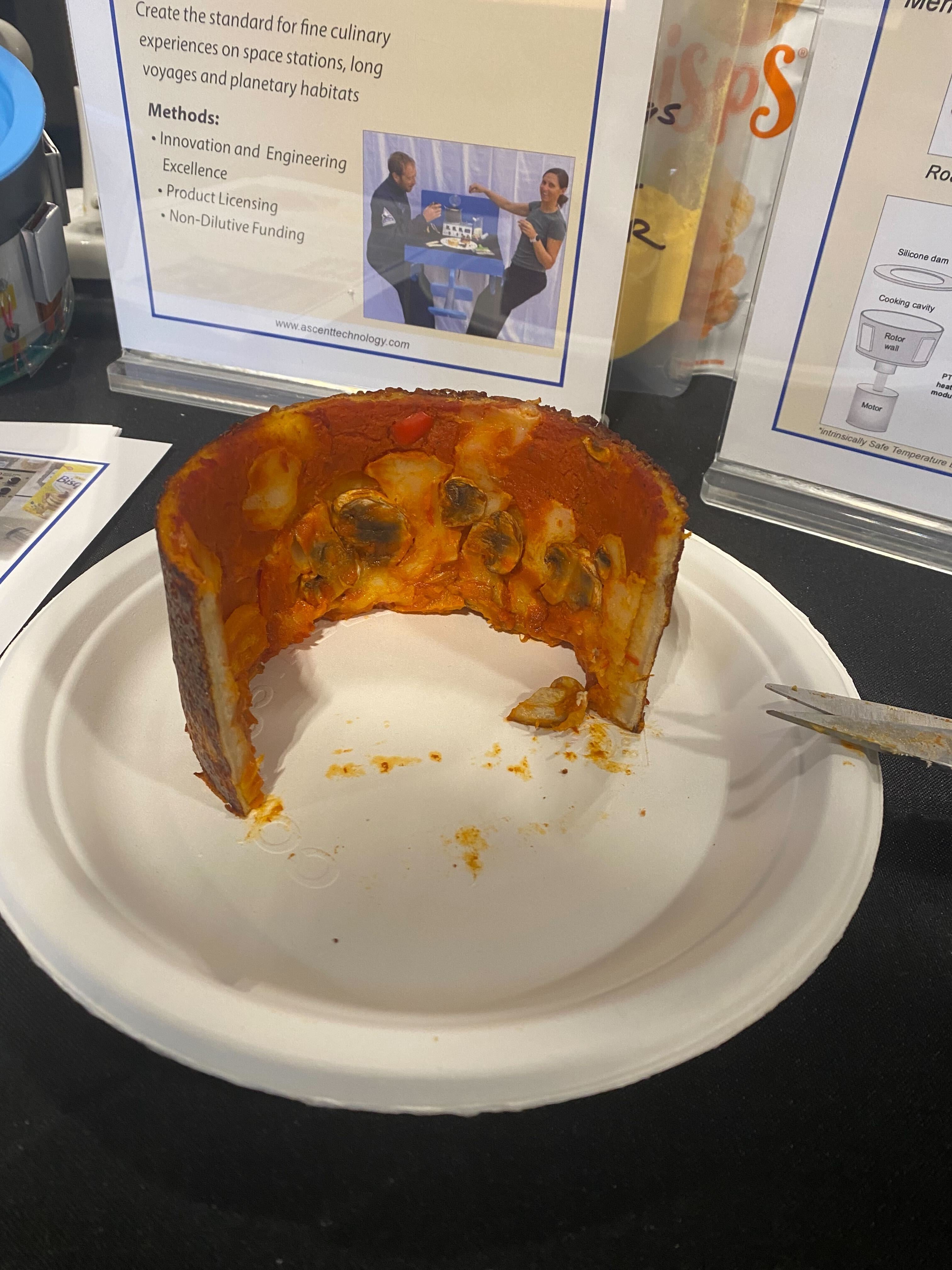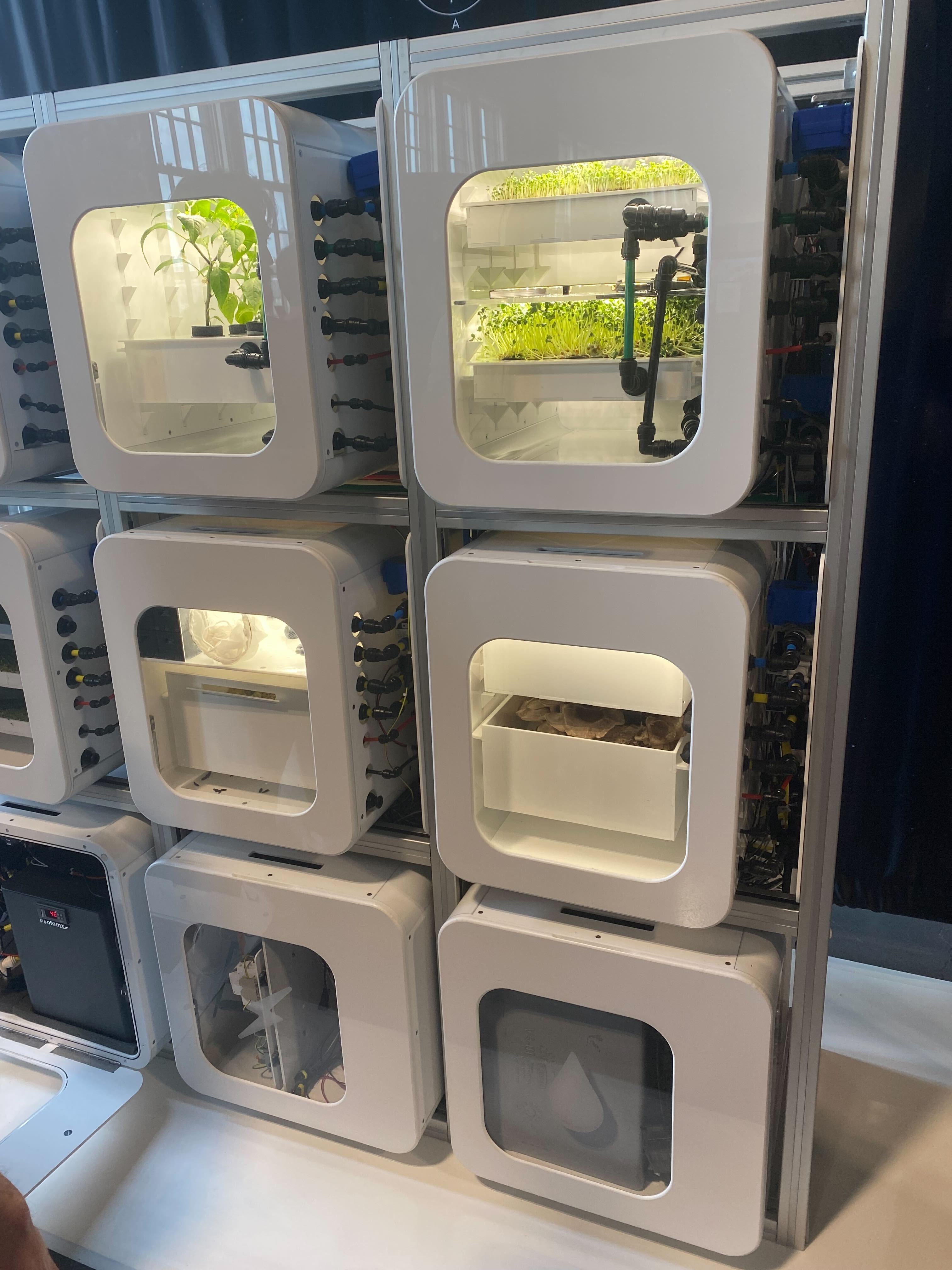Inside one of the massive brick-lined warehouses at the Brooklyn Navy Yard, more than a dozen teams laid out a rather odd display of food samples. Whether it’s a juicy meatball made from fungi, a batch of greens grown inside an ecosystem pod, or a wheel of mushy crust heated inside a gravity-defying device, this eclectic menu could one day feed astronauts travelling to the Moon and beyond.
Recently, NASA announced the winners of the second phase of its Deep Space Food Challenge. The announcement took place during an event held at the NYCxDESIGN Festival in New York, which showcased the work of the participating teams. In partnership with the Canadian Space Agency, the competition first called for novel food production technologies in January 2021 and is now entering its third and final phase.
Eight teams have been handed a cheque for $US150,000, and also their next challenge: scale these concepts for the final frontier. The winning U.S. teams are: Air Company, Interstellar Lab, Kernel Deltech, Nolux, and SATED. Three international teams also made the cut: Enigma of the Cosmos from Australia, Mycorena from Sweden, and Solar Foods from Finland.
Air Company of Brooklyn, New York, developed a system and processes for turning air, water, electricity, and yeast into food. Interstellar Lab of Merritt Island, Florida, created a modular bioregenerative system for producing fresh microgreens, vegetables, mushrooms, and insects. Kernel Deltech USA of Cape Canaveral, Florida, developed a system for cultivating mushroom-based ingredients. Nolux of Riverside, California, created a solution that mimics the photosynthesis that happens in nature to produce plant- and mushroom-based ingredients. SATED (Safe Appliance, Tidy, Efficient, and Delicious) of Boulder, Colorado, developed a space cooking appliance that would allow astronauts to prepare a variety of meals from ingredients with long shelf lives. Enigma of the Cosmos hails from Melbourne – the company has created an adaptive growing system to increase the efficiency of plants’ natural growth cycles. Mycorena of Gothenburg, Sweden, developed a system that uses a combination of microalgae and fungi to produce a microprotein. Solar Foods of Lappeenranta, Finland, created a system that uses gas fermentation to produce single-cell proteins.
The winning teams will now compete for $US1.5 million in total prizes for the third and final phase.
“The whole system is working very well, now we need to adapt for a space environment,” Barbara Belvisi, CEO of Interstellar Lab, one of the winning companies which manufactures controlled-environment biofarms, told Gizmodo at the event. “The whole design of the system is based on gravity, and now you’re going to get rid of gravity.”

The Deep Space Food Challenge draws on innovators in the food production industry to come up with solutions to one of spaceflight’s most pressing concerns: feeding the astronauts. NASA wants to send its astronauts farther than they’ve ever gone before, potentially setting up future habitats on the Moon and perhaps even on Mars. The food that astronauts rely on today, however, begins to degrade after around a year and a half. Just getting to Mars would take about seven months, according to NASA.
“The prepackaged food that we have now that we’ll be able to take with us to an extent, that’s going to provide the bulk of all the nutrition they need,” Ralph Fritsche, senior project manager for space crop production at NASA’s Kennedy Space Centre in Florida, told Gizmodo. “And so we’re of course trying to make up for that shortfall…and at the same time, trying to add variety to the diet.”
Scaling down for space
The majority of the participating teams have viable, working food production systems on Earth meant to address issues related to food sustainability. Those same solutions to challenges posed by climate change on Earth could also be viable for a microgravity environment or a terrestrial habitat on an alien world, since they address concerns like water scarcity. “We’re looking at controlled environment agriculture, vertical farming, and that’s all about how do I maximise a certain amount of volume to grow edible biomass,” Fritsche said. “And that’s what we need to do when we get to the Moon.”
The phase three finalists include the Brooklyn-based Air Company, which developed a system for turning air, water, electricity, and yeast into food. The idea is to take the carbon dioxide exhaled by astronauts, combine it with hydrogen produced by water electrolysis (which is where all the oxygen is produced on board the International Space Station (ISS)), turn that into a broth that contains alcohol and water, and feed that water to yeast for it to grow and make bread, for example.

“We’re really eager to see what phase three looks like to see if we can actually get stuff into space,” Stafford Sheehan, co-founder of Air Company, told Gizmodo. “This is all like the ground test, making sure it works here on Earth.”
Another company, Florida-based Kernel Deltech created a device that uses fungi fermentation to create plant-based food in different forms, like cheese or chicken nuggets, for astronauts on long-duration space missions. Pablo de León, the team lead for the company, explained that the unit was originally designed to solve issues of hunger in South America. “We did an adaptation to be used in space and built a machine that will fit inside a standard rocket,” he told Gizmodo.
The competing teams may not have been thinking about space when they first developed their ideas, but they are now all racing to prove that their concepts can be applied in the great beyond.
“Space today seems to be like the ultimate challenge,” Fritsche said. “They’ve proved their concept terrestrially, now they’re learning about the challenges of spaceflight with microgravity and the radiation environment in deep space.”
NASA’s Fritsche explained that some of the concepts are more feasible for near-term applications, while other innovative ideas could come into work around 30 to 40 years from now. “The challenge for us is that we have to figure out where can we introduce some of these concepts and the hardware that goes into it,” he said. “We don’t have that much space, that much power and all the other supplies that you would need, so we’re limited in that.”
Food for comfort

At the same time, some of the concepts address a more obvious nutritional need in terms of food, while others utilise food as a form of comfort for astronauts on long-duration missions. Colorado-based company SATED, for example, developed a space cooking appliance that would allow astronauts to prepare a hot meal. The appliance has built-in heaters and spins the ingredients in a circle at a high-speed like those dizzying zero-gravity carnival rides, which would prevent the food from flying off in space.
“There’s a behavioural health aspect that food brings into it, and it’s probably as important as the nutritional content,” Fritsche said. “Especially for people working in extreme environments on an exploration mission.”
Astronauts on board the ISS today enjoy a “fairly wide, diverse menu,” according to Fritsche. “Supposedly it’s fairly enjoyable,” he said. “So I don’t think that they’re hurting on what they’re doing now, it’s just keeping that food fresh, safe, and nutritious after a year and a half is the challenge.”
